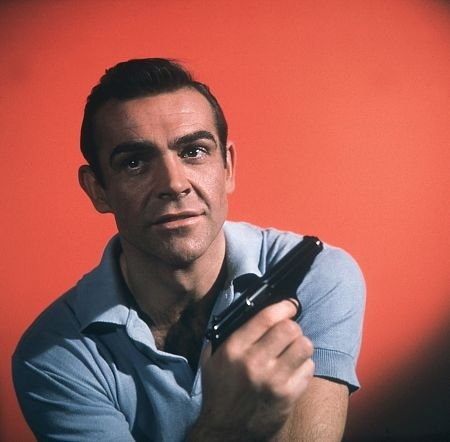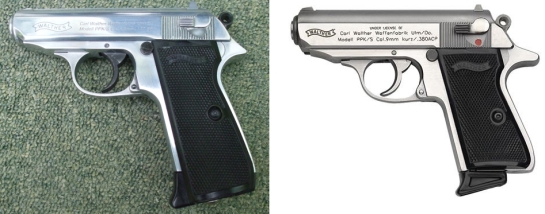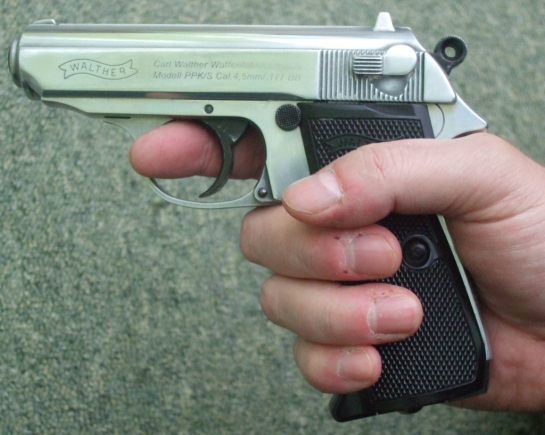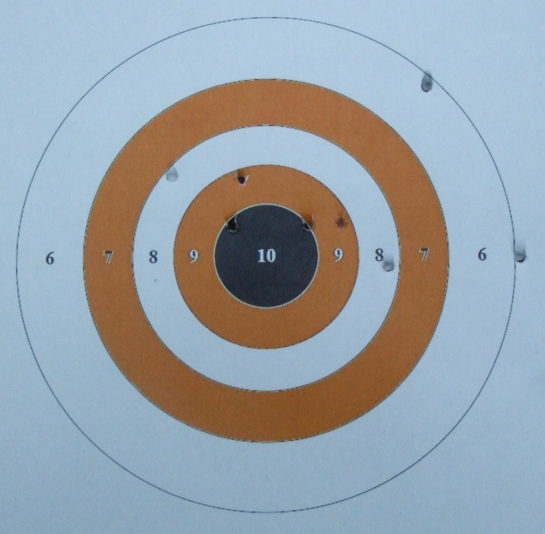I thought I’d start with a review of a replica of one of the most successful and well known semi-automatic pistols of the last hundred years – the Umarex Walther PPK/S. I have owned two Umarex PPKs – one in black and a polished model.
Real steel background
“It’s a real stopping gun.” Major Boothroyd, Dr No.
Carl Walther GmbH was founded in 1886 in the city of Zella-Mehlis in what was then the state of Hesse in Gernamy. The company initially made hunting and target shooting rifles, but in the early 1900s it began producing pistols. The company produced several moderately successful semi-automatic pistols before the Walther PP (Polizei Pistole) was released in 1929. The PP was designed as a sidearm for uniformed police officers and was a blowback operated, double action, semi- automatic pistol which could be chambered for 9mm, 7.65mm or .22 calibre rounds. It was one of the first mass-produced pistols to use stamped parts, and quickly gained a reputation for high quality and reliability. In 1931 the PPK (Polizei Pistole Kriminalmodell: Police Pistol – Detective Model) was introduced. This was similar in appearance to the PP, but featured a shorter barrel and smaller grip and was intended as a concealed-carry weapon for plainclothes or undercover work.
Looking at the PPK today, it’s hard to believe that this pistol was first produced more than eighty years ago. It’s a clean, classic and instantly recognisable design which also happens to be a useable and reliable handgun. It has been copied many times, but seldom bettered. It’s a testament to that fine basic design that it is still in production today, under license by Smith and Wesson in the USA.
.22 calibre Walther PPK, 1965
Picture courtesy http://www.adamsguns.com/ via Wikimedia commons
The PPK was very widely used by German police, security and armed forces before, during and after World War Two (Adolf Hitler shot himself with a 7.65mm PPK). Although movies and television shows would have us believe that the Luger was the typical German officers’ sidearm of this period, this was not the case. The Luger was issued as a sidearm only to NCOs and to selected specialized units such as paratroopers, tank crews and pilots. It was never an officer’s pistol. In the Wermacht, officers were provided with a clothing and equipment allowance from which they were expected to buy their own pistol. The small, light and reliable PP and PPK were overwhelmingly the most popular choices, generally in 7.65mm calibre.
The PPK and James Bond
“Not so much a killing machine, more of a personal statement” “Q”, Skyfall
But let’s be honest here; the principal reason the PPK is so well known (even amongst people who aren’t particularly familiar with firearms) is that it’s the weapon of choice for a certain British Secret Agent. Though this wasn’t always the case. For the first five Bond novels Ian Fleming equipped his hero with a .25 Beretta 418, an oddly effeminate choice of gun for such a macho character. It wasn’t until 1957 when he was writing Dr No that Fleming received a letter from Bond fan and firearms expert Geoffrey Boothroyd who pointed out that the Beretta was “a lady’s gun – and not a very nice lady at that!” Boothroyd suggested that it would be much more appropriate to provide Bond with a Walther PPK in 7.65mm calibre. Fleming agreed, and Boothroyd came to provide him with much useful advice about firearms over the years. In grateful recognition of this, a new character was introduced in Dr No; – Major Boothroyd, the MI6 armourer and head of “Q” Branch who is described as “the greatest small-arms expert in the world”. In the novel Bond is persuaded to reluctantly give up his Beretta and accept a PPK as his main weapon (though he doesn’t actually use the PPK in the story, choosing instead his backup weapon, a .38 Smith & Wesson Centennial Airweight revolver).
Sean Connery with PPK, 1962
When the first of the Bond films came to be made in 1962, the screenplay was based on Dr No, and so Sean Connery exchanged his Beretta for a PPK from the very start. In the movie version of Dr No, Bond uses the PPK and it continued to be 007’s screen sidearm for sixteen more films and 35 years, until Tomorrow Never Dies in 1997 at which point it was swapped for a Walther P-99. However, with the advent of Skyfall, the third film starring Daniel Craig as Bond, the character has once again reverted to using a PPK, albeit modified with a palmprint recognition system.
The Umarex PPK/S
So, when Umarex were looking for a weapon to use as the basis for their first replica blowback air pistol, the PPK was the obvious choice, particularly in view of their close links with Walther. The Umarex Walther PPK/S was introduced in 2002 and is a reasonably accurate visual replica of the original (though sadly it doesn’t include palmprint recognition). The PPK/S is a version of the PPK which is slightly larger than the original in order to comply with the US Gun Control Act of 1968 (since World War Two the USA has been the biggest market for the PPK). The Umarex PPK/S shoots 4.5mm steel BBs, is powered by CO2, has a 3½” smoothbore barrel and a drop-out magazine with a capacity of 15 BBs. The Umarex PPK is available in all-black finish, or black with a polished slide, or completely polished.
Packaging and presentation 2.5/5
Both My PPKs were purchased second hand and didn’t come with a box. If you buy a new one, it will come in a small and not especially impressive cardboard box containing the pistol, one magazine and a short user manual.
Visual accuracy 7/10
Overall size and appearance are close to the original and the replica features Walther markings. However, the outline is slightly different to the original – the rear frame extension appears to be shorter on the replica and the frame and grips are longer, presumably to accommodate the CO2.
Umarex PPK/S (left) and original 9mm PPK/S
There are a few other things which mar the visual accuracy of the replica. The safety catch mounted on the left hand side of the slide is moulded in place on the replica – the actual safety is a sliding lever at the upper front of the right grip. The tightening knob for the CO2 projects below the butt of the grip. On earlier models this is a substantial plastic “wing-nut”. On later models it’s a slightly less obtrusive but more flimsy folding plastic half-moon. On both my PPKs I replaced this with a less obtrusive screw (see article link at bottom of this post).
Original plastic tightening tab and stainless steel screw replacement
With the exceptions noted above this is a good visual replica of the original, which is probably unsurprising given that Umarex and Walther are part of a commercial joint venture. It is rumoured that some parts of the Umarex PPK/S are interchangeable with parts from the original.
Functional accuracy 11/15
This is a blowback pistol which operates in single action only (unlike the original which shoots in double and single action). The magazine is drop-out, but is a small, slightly flimsy plastic affair that is released by use of the magazine catch on the left of the grip. The magazine also incorporates the bottom front part of the grip. CO2 is stored in the frame and is inserted by removing the left-hand grip cover.
The slide locks back when the last BB is fired. However just as on the original, there is no slide catch – to release the slide it must be racked again with a loaded magazine or with no magazine in place.
As originally produced, the Umarex PPK/S could be correctly field stripped. The trigger guard was hinged at the rear, and moving the guard down and clear of the frame allowed the slide to be removed. However, a plethora of owner problems (if you’re not careful, it’s very easy to have a tiny spring twang off into the middle distance when you remove the slide) led to later models having the trigger guard pinned in place.
Shooting 25/40
When you pick this pistol up it’s immediately apparent that the ergonomics are very good indeed – although this is a small pistol it fits comfortably into the average man-sized hand and points very naturally.
The first thing you notice on firing is the kick from the blowback operated slide – it’s very strong and feels out of proportion to the small size of the pistol. It produces a satisfying bang too, and this coupled with the strong kick make it feel much more powerful than it really is. Running a six shot string of Blaster steel BBs over the chrono gave an average of only 270fps, though this was on a very cold day indeed.
Accuracy is variable – hardly surprising when you’re shooting BBs through such a short, unrifled barrel. Careful shooting in reasonable temperatures generally gives me groupings of around 3”, though with occasional flyers.
Eight shots, 6yds, steel BBs. Outer ring is 6″ diameter.
However, shooting in very cold conditions highlighted an unusual problem – while using the pistol prior to writing this review, I was shooting in a very cold conservatory where the temperature was well below freezing (though the CO2 was stored and loaded in a much warmer part of the house). Other pistols I shot on the same day worked as expected, though with predictably low velocities. The PPK/S however would only fire around ten shots with full power; after that it wouldn’t generate enough power to cycle the slide. However if I took it into a warm room for a few minutes it would recover and would be able to fire another ten shots or so before running out of oomph again. Odd; I don’t know whether it’s a foible of this particular pistol, or whether the Umarex PPK/S is especially susceptible to cold? In reasonable temperatures, you can expect to get around 60 full power shots from a single CO2.
Quality and reliability 12/15
This is a well-made, well finished, all metal replica (other than the plastic grips). Only the magazine feels a little flimsy. Black versions are painted rather than blued, but the paint is fairly thick and seems to be chip-resistant. There are no known reliability issues.
Overall Impression 13/15
Nice quality, good weight, good ergonomics, strong blowback and a loud bang all make this a very satisfying pistol to handle and shoot
Conclusion
This is a nice replica of a classic pistol. Like the original, the Umarex PPK/S is small, but good ergonomic design means that it doesn’t feel that way when you pick it up. It fits even large hands comfortably and points easily and naturally. This, combined with the loud bang and pronounced kick make shooting very satisfying, even if the actual measured power and accuracy aren’t particularly impressive.
Add to this the fact that this is a well-made and nicely finished pistol, and of course the cachet of the James Bond connection, and it’s easy to see why so many people choose to include an Umarex PPK/S in their collection.
Overall score: 70.5/100
Buy:
You can buy this replica at Pyramid Air here.
Related pages:
Classic Handguns – The Walther PPK
Umarex Walther CP99 Compact Review
How to remove the CO2 tab from an Umarex Walther PPK/S
Links










